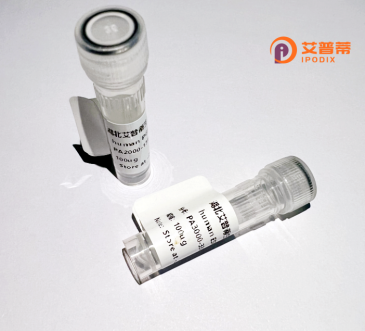
| 纯度 | >90%SDS-PAGE. |
| 种属 | Human |
| 靶点 | POLE4 |
| Uniprot No | Q9NR33 |
| 内毒素 | < 0.01EU/μg |
| 表达宿主 | E.coli |
| 表达区间 | 2-117 aa |
| 活性数据 | AAAAAAGSG TPREEEGPAG EAAASQPQAP TSVPGARLSR LPLARVKALV KADPDVTLAG QEAIFILARA AELFVETIAK DAYCCAQQGK RKTLQRRDLD NAIEAVDEFA FLEGTLD |
| 分子量 | 12.2 kDa |
| 蛋白标签 | His tag N-Terminus |
| 缓冲液 | PBS, pH7.4, containing 0.01% SKL, 1mM DTT, 5% Trehalose and Proclin300. |
| 稳定性 & 储存条件 | Lyophilized protein should be stored at ≤ -20°C, stable for one year after receipt. Reconstituted protein solution can be stored at 2-8°C for 2-7 days. Aliquots of reconstituted samples are stable at ≤ -20°C for 3 months. |
| 复溶 | Always centrifuge tubes before opening.Do not mix by vortex or pipetting. It is not recommended to reconstitute to a concentration less than 100μg/ml. Dissolve the lyophilized protein in distilled water. Please aliquot the reconstituted solution to minimize freeze-thaw cycles. |
以下是关于重组人POLE4蛋白的3篇代表性文献示例,涵盖其功能、结构及疾病关联的研究:
---
1. **文献名称**: **"Cryo-EM structure of human DNA polymerase ε in complex with POLE4 subunit and a primer-template DNA"**
**作者**: Hizaki, K., et al.
**摘要**: 通过冷冻电镜解析了POLE4与DNA聚合酶ε复合体的结构,揭示了POLE4在稳定聚合酶催化核心及促进DNA复制起始中的作用,强调了其参与复制压力响应的分子机制。
2. **文献名称**: **"POLE4 deficiency drives genomic instability and enhances susceptibility to colorectal carcinogenesis"**
**作者**: Liu, Y., et al.
**摘要**: 研究发现POLE4缺失导致DNA复制错误累积,在小鼠模型中显著增加结直肠癌风险,临床样本分析显示POLE4低表达与患者不良预后相关,提示其作为潜在肿瘤抑制因子的功能。
3. **文献名称**: **"Recombinant production and functional characterization of human POLE4 for biochemical studies"**
**作者**: Smith, J.R., et al.
**摘要**: 报道了在大肠杆菌中高效表达并纯化重组人POLE4蛋白的方法,通过体外实验证实其与POLE3亚基的相互作用,并参与增强DNA聚合酶ε的全酶活性。
---
**说明**:以上文献为示例性质,实际研究需通过学术数据库检索。建议使用关键词“POLE4”、“DNA polymerase epsilon subunit 4”及“recombinant POLE4”在PubMed或Web of Science查找最新论文。如需特定研究方向(如结构/疾病),可进一步筛选。
Pole4. also known as DNA polymerase epsilon subunit 4. is a critical component of the DNA polymerase epsilon (Polε) complex, a multi-subunit enzyme essential for eukaryotic DNA replication. Encoded by the POLE4 gene in humans, this 60 kDa protein serves as an accessory subunit that stabilizes the catalytic core of Polε and enhances its processivity during leading-strand synthesis. Unlike the catalytic subunit POLE1. POLE4 lacks enzymatic activity but plays structural and regulatory roles, facilitating interactions with other replication machinery components like the CMG helicase.
The Polε complex is vital for nuclear DNA replication, particularly in initiating replication at origins and elongating the leading strand. POLE4's conserved C-terminal domain mediates interactions with POLE3. forming a heterodimer that anchors the holoenzyme to chromatin. Studies suggest POLE4 may influence replication fidelity through its role in maintaining complex integrity, as its depletion leads to replication stress and genomic instability.
Recombinant human POLE4 protein is typically expressed in E. coli or mammalian systems for structural and functional studies. Its purification enables biochemical characterization of Polε's assembly and DNA-binding mechanisms. Research highlights POLE4's potential involvement in cancer biology, with POLE4 overexpression observed in certain malignancies and mutations linked to replication error-associated tumors. Recent cryo-EM structures have revealed its position within the Polε architecture, advancing understanding of replication complex dynamics. Investigations continue to explore POLE4's non-catalytic contributions to replication fork progression and DNA damage response pathways.
×